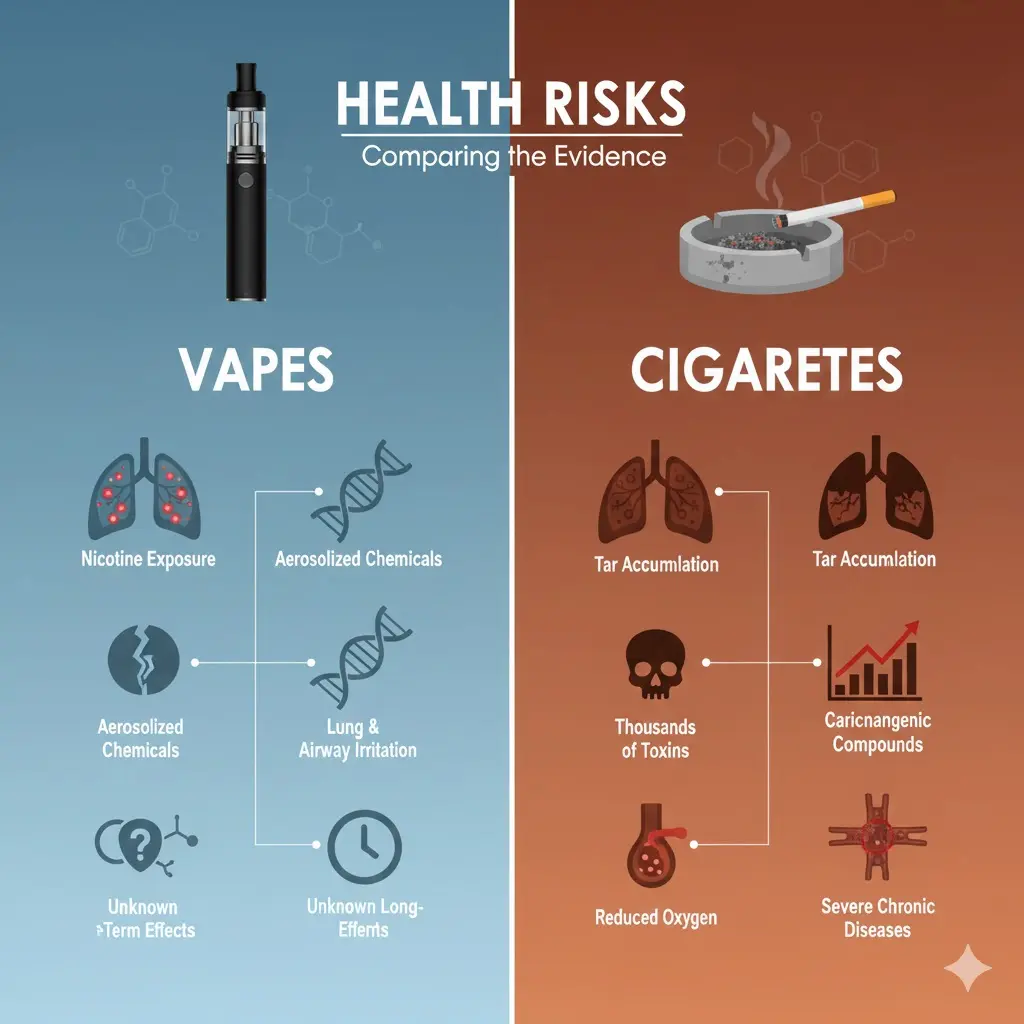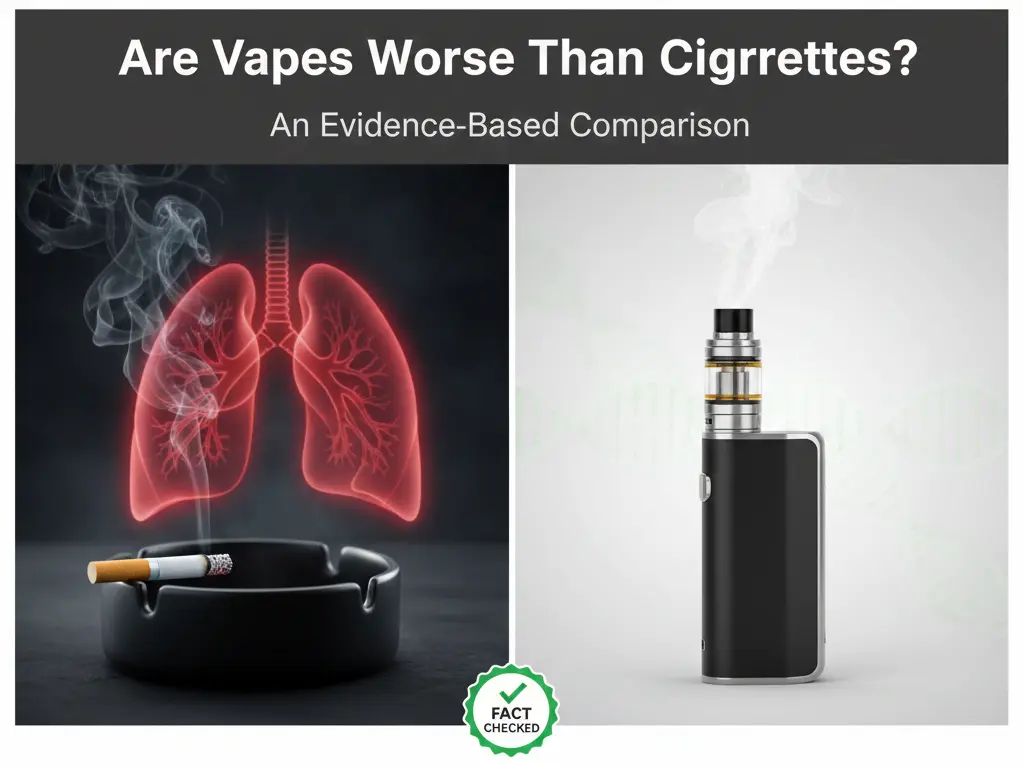Vaping and smoking are two of the most widely discussed nicotine delivery methods today. As e-cigarettes grow in popularity, people often ask: Are vapes worse than cigarettes? While both have risks, the way they work—and the type of chemicals they expose the body to—are very different.
This article provides a clear, unbiased, and research-informed comparison based on publicly available scientific and public health information.

Why People Compare Vaping and Smoking
The debate exists for several reasons:
- Cigarette use is declining, while vaping continues to rise.
- Many people believe vapes are “safer,” while others fear long-term unknowns.
- Public health agencies warn about risks for youth.
- Smokers often wonder whether switching to vaping reduces harm.
Understanding both products is essential for a fair comparison.
How Cigarettes and Vapes Work (Key Differences)
Cigarettes — Combustion-Based
Cigarettes burn tobacco at high temperatures, producing smoke that contains:
- Tar
- Carbon monoxide
- Thousands of chemicals
- Dozens of known carcinogens
Combustion is responsible for most of the long-term health damage associated with smoking.
Vapes — Aerosol-Based
Disposable vapes and e-cigarettes work by heating a liquid (not burning it). They produce an aerosol that typically contains:
- Nicotine
- Propylene glycol/vegetable glycerin
- Flavoring chemicals
- Low levels of other compounds
While vaping avoids combustion, it still exposes users to chemicals.
Health Risks of Cigarettes
Cigarettes are widely documented to cause severe long-term harm due to:
- Tar accumulation in the lungs
- Exposure to thousands of toxic chemicals
- Formation of carcinogenic compounds
- Carbon monoxide reduces oxygen levels
Long-term cigarette use is strongly associated with serious chronic diseases. These risks are well-established over decades of research.
Health Risks of Vaping
Vaping eliminates combustion but introduces a different set of concerns:
- Exposure to nicotine
- Inhalation of aerosolized chemicals
- Irritation of the lungs and airways
- Potential inflammation
- Unknown long-term effects due to the product’s relative newness
Health agencies emphasize that vapes are not harmless—especially for youth, non-smokers, and pregnant individuals.
| Category | Cigarettes | Vapes |
| Main Risk Source | Tar + toxic smoke from combustion | Aerosolized chemicals from heated e-liquid |
| Chemical Exposure | Thousands of toxic chemicals | Nicotine + aerosolized compounds |
| Carcinogens | Dozens of known carcinogens formed by burning tobacco | Fewer identified carcinogens; long-term data are still limited |
| Respiratory Impact | Tar accumulation in lungs; long-term damage | Lung and airway irritation; possible inflammation |
| Carbon Monoxide | High levels reduce oxygen in the blood | No combustion → no carbon monoxide |
| Long-Term Evidence | Strong evidence of severe chronic disease over decades | Long-term effects remain uncertain due to product newness |
| Nicotine Addiction | High addiction potential | High addiction potential; may allow more frequent use |
| Public Health Consensus | Proven severe harm | Not harmless; risks especially for youth, non-smokers, pregnant individuals |

Is Vaping Safer Than Smoking? What Public Health Agencies Say
Most public health bodies agree on several points:
- Cigarettes contain far more known toxic chemicals
Cigarette smoke contains over 7,000 chemicals, including tar and carcinogens.
- Vapes contain fewer toxicants but still pose risks
Aerosol chemicals can irritate lungs and may have long-term consequences that remain uncertain.
- Vaping may be less harmful than smoking — but not safe
Vaping avoids tar and many combustion byproducts, which is why it is generally considered lower in harm than cigarette smoking, but still risky.
- Non-smokers should not vape
It introduces unnecessary chemical exposure and nicotine addiction potential.
- Long-term studies are limited
The absence of decades-long data means unknown risks remain.
Nicotine Addiction: Vapes vs Cigarettes
Both products can cause strong nicotine dependence, but with different patterns:
Cigarettes
- Provide fixed doses of nicotine
- Dependence is often tied to ritual behavior
Vapes
- May allow higher or more frequent nicotine intake due to convenience
- Flavors increase appeal
- Youth are especially susceptible
Nicotine affects brain development in young people, making both products concerning for minors.
Chemical Exposure Comparison
| Category | Cigarettes | Vapes |
| Primary Chemicals | Tar | Nicotine |
| Main Carrier Compounds | Smoke produced from burning tobacco | Propylene glycol (PG) & vegetable glycerin (VG) aerosol |
| Combustion Byproducts | Carbon monoxide | No combustion — heated aerosol only |
| Additional Chemicals | Heavy metals | Flavoring chemicals |
| Volatile Compounds | Dozens of carcinogens formed through combustion | Small amounts of volatile organic compounds (VOCs) |
| Metal Exposure | Metals from burning tobacco & smoke particulates | Trace metals from heating coils |
| Toxicity Level | High and widely documented for decades | Lower exposure than cigarettes, but not risk-free |
Secondhand Exposure: Smoke vs Vapor
Cigarette Smoke
- Contains harmful chemicals
- Dangerous even at low levels
- Long-term exposure increases major health risks
Vapor
- Contains fewer toxicants than cigarette smoke
- Still not considered harmless
- Many public places regulate indoor vaping
Overall, secondhand smoke is clearly more harmful, but caution with vapor exposure is still advised.
Youth and Non-Smokers: Which Is Worse?
For people who do not smoke, vaping introduces risks that didn’t exist before, including:
- Nicotine addiction
- Chemical exposure
- Misuse due to flavors or accessibility
No health agency recommends vaping for people who are not already smokers.
So… Are Vapes Worse Than Cigarettes?
Here is a balanced summary:
| Category | Cigarettes | Vapes |
| Chemical Exposure | Far higher levels of toxic chemicals, tar, carbon monoxide, and thousands of combustion byproducts | Fewer toxicants; no combustion, but still contain chemicals and nicotine |
| Health Risks | Long-term effects are uncertain; known risks include chemical inhalation and lung irritation | Contains fewer recognized carcinogens, but is not risk-free |
| Nicotine Presence | Typically contains nicotine and can cause strong addiction | Often contains nicotine; easy to consume frequently, increasing addiction potential |
| Combustion | Yes — smoke produced from burning tobacco | No — produces aerosol through heating, not burning |
| Carcinogens | Contains dozens of known carcinogens produced by combustion | Contains fewer recognized carcinogens, but not risk-free |
| Overall Harm | High, widely established harm | Lower than cigarettes but not harmless |
| Public Health Consensus | Vaping is likely less harmful than smoking cigarettes, but more harmful than not vaping at all. | |
Should You Vape If You Don’t Smoke?
No. There is no benefit for non-smokers, especially given the nicotine addiction risk and potential unknown long-term effects.
Final Thoughts
Whether vapes are “worse” than cigarettes depends on what you compare:
- For smokers: vaping may reduce exposure to certain harmful chemicals compared to cigarettes.
- For non-smokers: vaping introduces unnecessary health risks.
- For youth: both products pose significant concerns, particularly with nicotine addiction.
The safest choice will always be not to use either, but understanding the difference helps people make informed decisions.
You Can Read More
Why Is My Vape Leaking? Simple Reasons & Easy Fixes
How Does a Vape Cartridge Work? (Simple Guide for Beginners)
How Long Do the Balls in a Ball Vape Last? A Real-World Lifespan Breakdown
FAQ (Search-Intent Optimized)
1. Are vapes worse than cigarettes?
Most evidence suggests vapes expose users to fewer harmful chemicals than cigarettes, but they are still not harmless and carry their own health risks.
2. Is vaping safer than smoking?
Vaping avoids tar and combustion, which may reduce some risks, but public health agencies emphasize that vaping still has health impacts, and long-term effects are not fully known.
3. Do vapes contain fewer chemicals than cigarettes?
Yes. Cigarettes contain thousands of chemicals, while vapes contain fewer; however, the chemicals in vape aerosol can still irritate the lungs and are not risk-free.
4. Can vaping cause addiction?
Yes. Vapes often contain nicotine, which is highly addictive. Some vapes may deliver nicotine more easily or in higher amounts than cigarettes.
5. Should non-smokers vape?
No. Vaping is not recommended for non-smokers because it introduces avoidable health risks, nicotine addiction, and chemical exposure.
